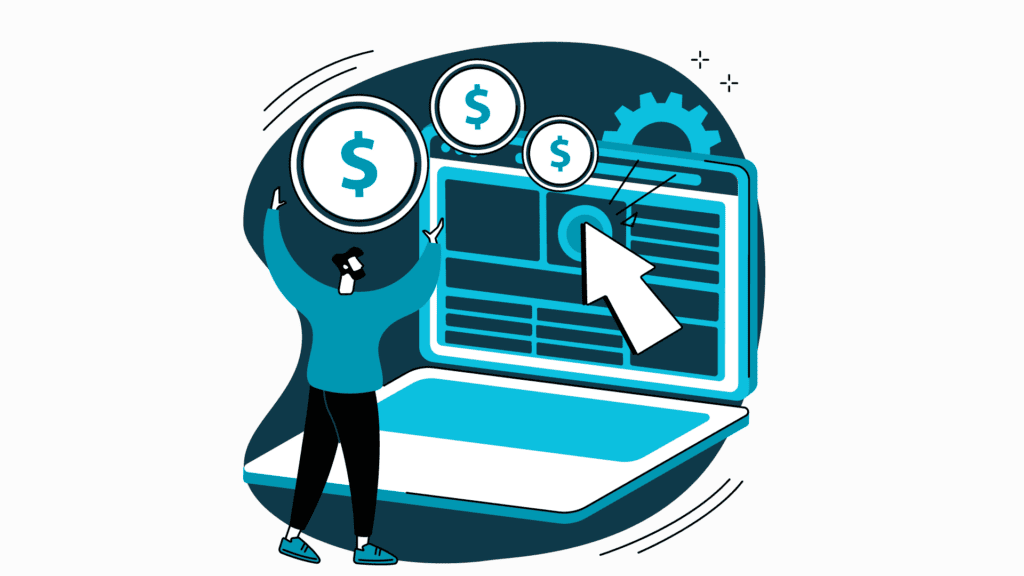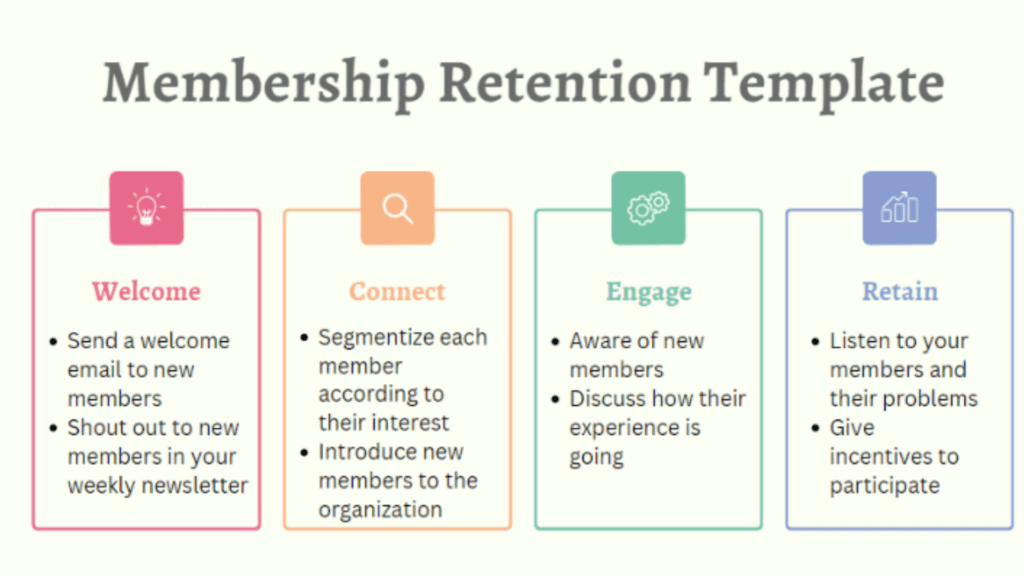Last Updated: October 2, 2023
Have you ever wondered why some businesses and organizations thrive while others struggle to survive? 🤔
What sets apart those who achieve long-term success from those who constantly have to replace their members? 🔁
The answer often lies in one critical factor: MEMBER RETENTION!
📚 Why You Should Read This? 📚
Curious about what membership retention is? We’ll decode their secrets, explaining how and why they’re used, so you can make the most of them.
We are ready to expose you to everything you wonder about in the membership related retention, please keep scrolling!
🔑 Key Points We’ll Explore:
- The Basics of Membership Retention
- Understanding of Membership Churn
- Retention Rate for Membership
- Measuring and Monitoring Retention
- How do you increase membership retention?
- Sources and Tools for Membership Retention
- 15 Membership Retention ideas and strategies
- Bonus – Free Membership Retention Template
📢 The Importance of Membership Retention
Membership retention is the lifeblood of any successful business or organization.
It’s not just about attracting new members; it’s about keeping them engaged, satisfied, and loyal.
This is because the benefits of retaining members extend far beyond the obvious, such as a steady stream of revenue.
📢 The Significance of Retaining Members for Businesses and Organizations
When businesses and organizations prioritize member retention, they create a loyal customer base that can serve as brand advocates, spreading positive word-of-mouth and attracting new members.
Retained members also tend to spend more over time, increasing the average transaction value and overall revenue.
Furthermore, retaining members is often more cost-effective than acquiring new ones.
Customer acquisition can be expensive, involving marketing and advertising expenditures.
In contrast, keeping existing members engaged typically requires less investment and yields greater returns.
The Basics of Membership Retention
Keeping members doesn’t just mean keeping things the same; it means setting the stage for growth and success.
Focusing on keeping your present members happy and involved will help you build a group of loyal supporters that will help you reach your long-term goals.
What is Member Retention?

In its simplest form, member retention means that a business or group can keep its existing members interested, happy, and involved for a long time.
In order to keep the relationship between the group and its members strong, both parties must actively work to grow and strengthen it.
This can include a variety of plans and actions that are meant to keep members interested and make sure they continue to get value from their membership.
The Importance of Membership Retention
Keeping members is a key part of making sure that businesses and groups stay open and successful. Because of this, it’s so important:
- Stability and Predictable Revenue: Members who are kept on provide a steady and reliable source of income. This steadiness is especially important for businesses because it means they don’t have to depend on sudden jumps in new customers.
- Cost-Efficiency: It can be pricey to get new members because of the costs of advertising and marketing. On the other hand, keeping current members usually takes less work and money, making it a cost-effective approach.
- Loyalty and Advocacy: Members who are kept on are more likely to stay with your business or group and support it. They can help build a good brand image by inviting new users and leaving good reviews.
- Increased Lifetime Value: Members who stay with your group tend to become more involved and spend more money over time. This increases their term value, which means they bring in more money than new users usually do.
- Community and Engagement: Keeping people in groups like clubs and non-profits helps build community and engagement. Members who stay involved are more likely to do more for the group, give their time, and help it reach its goals.
Understanding of Membership Churn
To understand member retention, you must first understand what a membership churn is.
Understanding and analyzing member churn is essential for any membership-based business or organization.
It provides insights into areas for improvement, allows for proactive intervention, and helps maintain a strong and loyal membership base.
What is Membership Churn?

Membership churn, which is sometimes just called “churn,” is an important statistic that shows how many people stop being members of a business, organization, or service within a certain amount of time.
Basically, it shows how many people leave or “turn over.” When you divide the number of members who leave during a certain time period by the total number of members at the start of that period, you get the churn rate.
This measure is very important for figuring out how healthy and long-lasting a membership-based organization is.
📈 Analyzing Member Churn
When you look at member churn, you have to look at all the reasons why members are going and the things that cause them to leave.
Here are some key steps in analyzing member churn:
1️⃣ Data Collection: The goal is to collect information about which members quit during a certain time period.
This information should include things like why the person is going, how long they were a member, and any themes or trends.

2️⃣ Segmentation: Put your leaving members into groups based on actions or traits they share.
This can help you figure out what problems or trends are causing people in certain groups to leave.
3️⃣ Identify Root Causes: Look into the reasons why people are going.
Customers often leave because they are unhappy with the goods or services, the high membership fees, not being involved, or a better offer from a rival.
4️⃣ Feedback and Surveys: Use exit interviews or surveys to get feedback from people who are leaving the group.
Their opinions can give you useful information about how to make things better.
Also, talk to people who have been with you for a long time to find out what has kept them interested and loyal.

5️⃣ Benchmarking: To get a better idea of how well your business is doing, compare your churn rate to standards in the same field.
If your churn rate is much higher than the average for your industry, you may need to take action right away.
6️⃣ Predictive Analytics: Figure out which people are likely to leave by using predictive analytics.
In this way, you can reach out to users and talk to them before they decide to leave.
7️⃣ Implement Retention Strategies: Use your research to come up with and put into action specific retention strategies.
Some of these could be better customer service, making your products and services more valuable, changing your prices, or starting engagement programs.
8️⃣ Monitor Progress: Always keep an eye on how your retention tactics are working and make changes as needed.
To keep your organization’s membership base healthy and stable, you should do churn research on a regular basis.

Retention Rate for Membership
After the membership churn term, you’re ready to understand the retention rate concept.
So, here you go!
What is the Retention Rate?

The retention rate is a way to figure out what percentage of people stay with a membership-based business or group for a certain amount of time.
This number measures how well the group can keep its members and is found in this way:
Calculate the retention rate by dividing the number of members at the end of a period by the number of members at the beginning of the period.
Basically, it tells you what percentage of your original membership you were able to keep for a certain amount of time.
What is a Good Retention Rate for Membership?
The best retention rate can be very different depending on the type of organization, the business, and the goals and circumstances of your membership-based group. A good return rate might not mean the same thing to different businesses.
However, here are some general guidelines:
📌 Industry Standards: If you can find them, it’s often helpful to compare your retention rate to standards for your field.
Typical retention rates may be different in different fields and businesses. In terms of your friends, this can help you figure out where you stand.
📌 Stability: An excellent return rate should show steadiness and long-term success.
If your group has a high retention rate, it probably does a good job of keeping its members involved and happy.
📌 Growth Objectives: Think about the growth goals for your group. A high retention rate is important if you want to keep your user group stable and loyal.
As a trade-off for wanting to grow quickly, you might be willing to accept a lower retention rate.
📌 Segmentation: Look at the rates of member renewal for each group of members.
Different communities, like long-term members or people with certain traits, might have different accepted retention rates.

📌 Historical Performance: Look at how many employees have stayed with your company in the past. Are they getting better, getting worse, or staying the same?
A good trend toward better retention rates could mean that strategies for keeping employees are working.
📌 Profitability: Think about how profitable your client base is. Keeping high-value members who bring in a lot of money might be more important than keeping low-value members.
📌 Cost of Acquisition: Find out how much it costs to get new users and how much it costs to keep old ones. When the cost of retention is smaller, it may be okay to have a slightly lower total retention rate.

🧮 How to Calculate Your Member Retention Rate?
To find your member retention rate, all you have to do is count how many people you have at the beginning and end of a certain time period.
Here’s how to figure out your member renewal rate, step by step:
- Determine the Time Period: Choose the time period for which you want to find the recall rate. Periods like monthly, weekly, or yearly are common.
- Count the Starting Members: At the start of the time period you picked, add up all the members you had. This is where you should begin.
- Count the Ending Members: At the end of the same time period, make a list of all the members you have. This is where you end.
- Calculate the Retention Rate: To figure out your user retention rate, use this formula:
Retention Rate: [(Ending Members – New Members Acquired During the Period) / Starting Members] x 100
- To focus on keeping current members, take the total number of ending members and subtract any new members that were added during that time.
- Divide this number by the number of people who started.
- To get the return rate as a percentage, multiply it by 100.
- Interpret the Result: The estimated retention rate reveals the number of members you kept over the specified time period.
When it comes to keeping members, a higher percentage means they stay with the group longer, while a lower percentage means they leave more often.
Measuring and Monitoring Retention

🔁 Retention Rate
A key metric used to track and measure how many members or customers a business or group is able to keep over a certain amount of time is the retention rate.
To figure it out, you have to compare the number of users or buyers at the start and end of the time frame you choose.
If the renewal rate is higher, it means that members or customers are more loyal and happy.
Keeping an eye on retention rates helps businesses figure out how well they can keep people interested and happy, which is important for long-term growth and success.
❌ Churn Rate
Another term for retention rate is churn rate. It figures out what percentage of members or users stop doing business or volunteering with a group during a certain time period.
Most of the time, to find the loss rate, you take the number of new members or customers you got during the period and remove it from the number of members or customers you had at the start of the period.
Then, you divide the result by the number you had at the beginning. A high loss rate could mean that customers aren’t happy with the product or service, the quality isn’t good enough, or there are too many competitors.
Getting rid of churn is important for many businesses and groups because it can cost more to get new members or buyers and cause them to leave.
Member Lifetime Value
LTV stands for “member lifetime value.” It shows how much money a member is likely to bring in for an organization or company over the course of their participation.
It looks at things like how much the person spends, how long they’ve been a member, and how likely they are to send others or make more purchases.
By knowing how much a member is worth over their career, businesses can make smart choices about their marketing, strategies for keeping members, and investments in getting new members.
Increasing member involvement, happiness, and loyalty is often a part of maximizing LTV.
Net Promoter Score (NPS)
Net Promoter Score (NPS) is a way to measure how happy and loyal a group of members or buyers is as a whole.
One question is used to find out: “On a scale of 0 to 10, how likely are you to recommend our organization to a friend or coworker?”
People who answered are put into three groups based on their scores: Promoters (scores 9–10), Passives (scores 7–8), and Detractors (scores 0–6).
To find the NPS, take the percentage of Detractors and remove it from the percentage of Promoters.
A high NPS score means that members or customers are very loyal, while a low score means that efforts to keep members and customers need to be improved.
NPS is a useful tool for figuring out how members feel emotionally connected to a group and finding ways to make the member experience better.
How Do You Increase Membership Retention?

Any business or organization that wants to be successful at member retention.
🗝️ Tip: Remember that the best ways to keep members may change depending on your business, the type of organization you run, and the types of members you have. Check-in on your work often, and be ready to change your plans if a member’s needs and standards change.
Here are some strategies that will help boost membership retention:
1-Provide Value and Quality:
- Make sure that your perks, goods, or services always meet or go beyond what members expect.
- Check the quality of what you offer often and make improvements to make sure it stays useful and current.
2-Engage and Communicate:
- Set up important ways for your people to talk to you on a regular basis.
- Send members customized notes, newsletters, and information to keep them interested and up to date.
- To reach people where they are, use a variety of ways to communicate, such as email, social media, and in-person events.
3-Create a Sense of Community:
- Encourage people to feel like they are part of a group.
- Encourage people to talk and connect with each other, whether it’s through events, online groups, or networking opportunities.
- To motivate other people, show off success stories and member feedback.
4-Offer Exclusive Benefits:
- Give members special benefits, deals, or access to information that other people can’t get.
- Make sure that these perks are useful and important to the people you want to reach.
5-Solicit Feedback:
- Ask members for feedback to find out what they want, what they need, and what hurts them.
- To get information, you can use polls, focus groups, or one-on-one conversations.
- Show that you value what your members have to say by making changes based on what they say.
6-Personalize Experiences:
- When you can, make your services and messages fit the tastes of each person.
- You can divide your viewers into groups and give each group a unique experience by using data analytics and user profiles.
7-Recognize and Reward Loyalty:
- Celebrate important events with long-term members, like birthdays or accomplishments.
- Set up loyalty programs or membership levels with perks that get better as people stay with you.
8-Educate and Upsell:
- Help members get the most out of their membership by giving them teaching materials or training chances.
- As your members’ needs change, give them the chance to buy more services or special packages.
9-Focus on Onboarding:
- Watch out for the process of getting new members up to speed. From the start, make it simple for them to understand and use their rewards.
- Give newbies mentors or buddy systems to help them fit in with the group.
10-Monitor Engagement Metrics:
- Track regularly member involvement measures, like the number of people who participate, show up to events, or use benefits.
- These measures can help you find trends and places where you can improve.
11-Implement Retention Campaigns:
- Create focused retention programs that will get members who have shown signs of losing interest back in the group.
- Offer incentives to get them to keep participating.
Sources and Tools for Membership Retention

Keeping members can be helped by many sources and tools that offer information, analysis of data, and ways to communicate.
🗝️ Tip: Keep in mind that the tools and sources you choose should fit the wants, goals, and resources of your company. Check-in on a regular basis to see how well these tools and sources are working to keep members and make changes to your plans as needed.
Here are some useful sites and tools for keeping people longer:
Customer Relationship Management (CRM) Software
CRM software helps you keep track of contacts with members, handle their information, and send them more personalized messages to improve your relationships with them.
💡 Example: A lot of businesses and organizations use Salesforce as their CRM tool to keep track of contacts with customers and automate marketing and sales tasks.
Email Marketing Platforms
With email marketing tools like MailChimp or HubSpot, you can send users tailored and personalized emails that encourage them to interact and communicate.
💡 Example: MailChimp is a well-known email marketing tool that lets users make and send email campaigns, divide their audience into groups, and look at how well their campaigns are doing.
Surveys and Feedback Tools
You can get feedback from users using tools like SurveyMonkey or Google Forms. This will help you figure out what they need and how satisfied they are.
💡 Example: SurveyMonkey is a flexible online survey tool that firms can use to make polls, get answers, and then look at the results to improve their services.
Social Media Management Tools
Hootsuite and other social media management tools help you interact with users on social media, share information, and create a sense of community.
💡 Example: Hootsuite is a social media management tool that lets businesses and groups plan posts, interact with their followers, and keep an eye on what’s happening on social media across multiple platforms.
Online Community Platforms:
Using online community platforms like Discourse or Slack can make it easier for users to talk to each other and make them feel like they belong.
💡 Example: Discourse is an open-source platform for online communities that helps groups make conversation boards and encourages members to connect and get involved.
Member Directories and Profiles:
Adding member directories and profiles to your website or app makes it easier for members to connect with each other and gives them a sense of belonging.
Example: Members of LinkedIn can make profiles, connect with others, and join interest-based clubs and groups. LinkedIn is a business networking site.
15 Membership Retention Strategies and Ideas
- Offer exclusive content or resources
First membership retention strategy is that providing exclusive material or resources to members. This helps retain members and adds value.
Unique information like research papers and industry insights can help member retention.
- Create tiers of membership
Different membership tiers with increasing rewards and privileges will encourage members to stay active and upgrade.
This lets members pick the membership level that meets their requirements and budgets.
- Host member-only events or webinars
One of the membership retention strategies is that they and other members may meet other members, learn from experts, and feel like a group at member events or webinars.
It may also add value and engage consumers. Choose subjects or themes that interest members and allow them to network at member-only events.
- Create a member referral program
Rewarding members who recruit new members gets them active and engaged.
Give members incentives or recognition for successful referrals to motivate them to promote the organization and extend its membership.
- Provide exceptional customer service

One of the other retention strategies is to provide excellent customer service to retain users. Responding immediately to member issues may establish trust and loyalty.
Making it simple for members to contact the group by phone, email, or chat may also raise satisfaction and retention.
- Celebrate milestones and anniversaries
Other one of the membership retention ideas is that celebrating milestones like membership anniversaries is a simple yet effective way to show members you care.
Sending handwritten messages or modest presents of appreciation may foster community and engagement.
- Create online discussion forums or communities
Good member retention ideas, one of them, could be a location online where individuals can connect, communicate, and exchange ideas might make them feel like part of a community.
Create a space where members may speak and learn from one another to retain members.
- Conduct member surveys and act on feedback
One of the membership retention strategies is that customer service may help firms understand members’ requirements, preferences, and pleasures by regularly soliciting input.
Using feedback to enhance services and resolve issues shows members that their ideas are valued.
- Offer flexible payment options
Offering flexible payment schedules can help members achieve their financial commitments and reduce renewal hurdles.
Members can have financial control by choosing monthly or quarterly billing. This can be good one of the member retention ideas.
- Enhance the membership experience

One of the other membership retention ideas is that a game-like element can make the encounter more engaging. Group members who receive points or badges for completing tasks or reaching milestones are more inclined to stay.
- Offer ongoing education and training
Educational resources, webinars, and workshops may help members upgrade their abilities or learn about their company or hobby.
Through continual education and training, the group may demonstrate its commitment to member achievement. This can be a one of the member retention ideas.
- Partner with relevant businesses or organizations
One of the another membership retention ideas is that your members can benefit from partnering with complementary companies or groups. Working with these partners helps attract and retain members through discounts or incentives.
- Take some help from social media
Share relevant material, respond to comments, and establish discussions with individuals on social media.
Make your club seem like a community beyond its website and app. LinkedIn, Twitter, Facebook, and Instagram may help members feel included and involved.
Regular updates and materials can keep members aware of your organization and encourage renewals.
- Implementretention-focused onboarding process
One of the other membership retention ideas is that warmly greet them, give them some tools to get started, and lead them to immediately comprehend and value their membership.
By appropriately welcoming new members, you can ensure they get the most out of their membership from the outset, making them more inclined to stay.
- Offer trial periods or guarantees of money back

Last but not least, one of the membership retention strategies is that give prospective club members a trial or money-back guarantee. This reassures them and increases the likelihood of a long-term contract.
Give a trial period or money-back guarantee to convince potential members that you appreciate your membership program and care about their enjoyment.
Free Membership Retention Template
This is a membership retention plan template. You can download this for free. We’ve added some titles and tips for you.
You can change the membership retention plan template according to your own organization, set a strategy, and retain your current members.
Also, you can bring new members to your organization.

Last Words on Membership Retention
It’s time to part.
We’re just kidding 😂, but we are happy to say that you have come to the end of this post.
We hope you found every detail you were looking for.
Let’s see what we talked about briefly, shall we? ✨
It’s impossible to say enough about how important member retention is. Organizations and communities alike need to do this in order to be successful in the long term.
It’s important to keep members because they help you build a loyal customer base that supports the organization.
Over time, these loyal members tend to spend more, which increases total income and lowers the cost of getting new customers simultaneously.
To better understand how to keep members, we’ve learned about important ideas like figuring out retention rates, understanding and studying membership churn, and the tools and resources that can help you make effective retention strategies.
As you start to keep your members, keep in mind that it’s an ongoing process that requires you to be flexible and know how to meet the changing needs of your members.
FAQs about Membership Retention
1-What is membership retention?
Membership retention is the effort to keep members engaged and satisfied over an extended period, fostering a strong and lasting relationship between the organization and its members.
2-Why is it important?
It’s crucial for stable revenue, cost-effectiveness, loyalty, and community building.
3-How do you calculate the retention rate?
Divide the number of members at the end of a period by the number at the beginning, then multiply by 100 for a percentage.
4-What’s a good retention rate?
A high rate signals strong engagement and loyalty, but it varies by industry.
5-How do you increase retention?
Enhance value, communicate, build community, offer exclusives, gather feedback, personalize experiences, reward loyalty, focus on onboarding, and monitor engagement.









